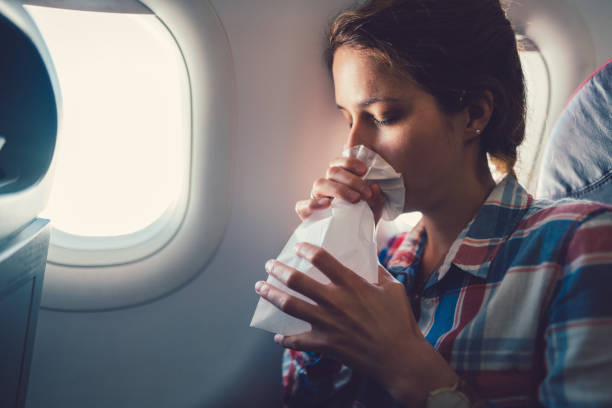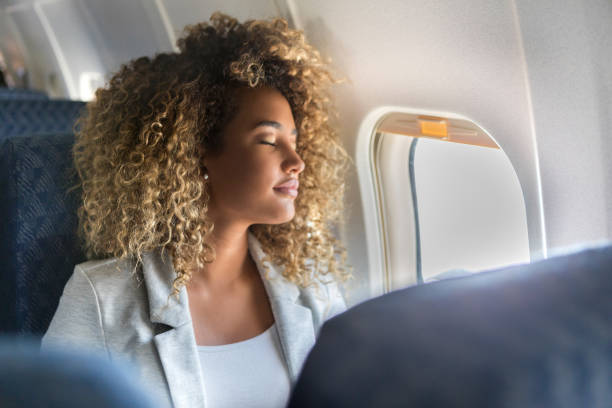Fear of flying is more common than many people think—and it can make even the idea of travel feel overwhelming. Whether it’s the lack of control, fear of crashing, or discomfort with enclosed spaces, flight anxiety can turn vacations or work trips into major sources of stress. But the good news? There are simple, effective ways to manage it and feel more in control.

What Causes Fear of Flying?
Fear of flying (also known as aviophobia) often stems from a mix of psychological and physical triggers. While some people have a specific traumatic experience tied to flying, others may struggle with the uncertainty, lack of control, or the physical sensations of takeoff and turbulence.
Common Thoughts and Triggers
- Catastrophic thinking: “What if the plane crashes?”
- Claustrophobia, or fear of being trapped.
- Past bad experiences on flights.
- Fear of panic attacks in the air.
- Turbulence or unfamiliar noises during the flight.
- Lack of control and being far from help.
3 Tools to Manage Flight Anxiety
1 – Learn the Facts About Flying
When we are in an emotional state, it can be easy to forget that there is logic attached to our thoughts and fears. While nothing in life is guaranteed, the statistics and facts about flying can help to put actual risk into perspective, as well as explain incidental things about flying that cause you distress. Deepening your understanding of an issue is something I see the benefits of as an anxiety counselor in Woodland Hills.
- The fact is that flying is safe. Remind yourself: flying is statistically one of the safest ways to travel. The reason it feels dangerous is because being in the air is more vulnerable than being on the ground. This feeling is innate, and anything we hear to validate our fear stands out and is retained more easily because of the emotional power of fear. The reason flying can seem like a statistically riskier mode of transport is because we hear about every aviation mishap that occurs. Consider this: how rare must flight disturbances be in order to be reported on? Imagine if every car accident was reported upon; the news wouldn’t talk about anything else.
- Understand what those bumps and noises are. Watch videos or read trusted sources explaining how planes work and what turbulence really means. While you’ll never turn into an engineer or become a pilot from doing so, being able to understand why these disruptions happen, and what they really mean, can help you in having a more relaxing flight. You may find websites and blogs that you find useful; you might also want to look on social media for aviation enthusiast groups and take a look at their conversations. You could also visit a flying club and see what information they have to share. Many pilots have a passion for sharing their wisdom and knowledge, and it also helps to see how many of them have been flying for years.
- Hiding your head in the sand feels safer, but it’s not helping with your fear. It can be tempting to avoid subjects that cause us distress. “I don’t want to think about it,” is what most people say. However, when we don’t have facts, we are forced to fill in the gaps in our knowledge with imagination and emotion. Understanding the process of flight can reduce the “unknown” factor that fuels fear. The hardest step is likely deciding to start learning. You might want to recruit a friend or family member to learn with you!
2 – Practice Grounding Techniques Before and During the Flight

While aviophobia is a specific fear, the way to tackle it is accessible to anyone who struggles with any kind of anxiety. In fact, the tools used by those who struggle with generalized anxiety are the same as those you can use to calm your mind and body before and during your travels. These are the tools we teach and discuss in our Woodland Hills anxiety therapy sessions.
- Use deep breathing. Inhale for 4, hold for 4, exhale for 6. Repeat until your body calms. You can do this before the flight and during the flight as well. The great thing about it is that it requires no equipment, no power source, no specific environment. It’s just you and your body, working together to help your nervous system decompress. Slowing your breathing can help your muscles relax, and your heart rate lower.
- Don’t discount equipment! Yes, it’s great that you can breathe any time, any place. But that doesn’t mean you can’t set yourself up for greater success by using tried and true anxiety hacks. Bring a calming toolkit: fidget toys, noise-canceling headphones, soothing music, or a meditation app. Give yourself the advantage. Something small that you can pack in your carry-on could end up being of great use to you during the flight.
- Use your senses to connect with your body. Try the 5-4-3-2-1 method to stay grounded in the present moment. Name 5 things you see, 4 you feel, 3 you hear, 2 you smell, and 1 you taste. You might think that if you are anxious, the last thing you want to do is be present in the moment. While closing your eyes and listening to music can help you to tune out a frightening environment, it is also important to be able to bring yourself to reality if you are experiencing a mental spiral. Ruminating about past scares or catastrophizing about what you think is going to happen will not help you be calm.
3 – Challenge Negative Thinking Behind Your Anxiety
The improvements made by challenging negative thinking for those who see us for anxiety therapy in Woodland Hills cannot be overstated. In both in-person and online anxiety therapy, you can learn and practice the tools needed to interrupt harmful thoughts and redirect your energy.

- Identify and label your thoughts. Feeling anxious comes along with anxious thinking, and each can feed off one another. In order to challenge negative thinking, you first have to recognize it. Begin by identifying the thought without assigning judgment to it. Rather than thinking, “Here we go again, I am anxious. I hate that I do this; why can’t I get over it?” tell yourself instead, “I notice that I am worried about being in a small space for the next three hours.” Stop the sentence after you identify the thought and before you can extrapolate what it “says about you”.
- Determine if this thought is helpful or not. The idea of an anxious thought being helpful likely doesn’t sound realistic. But the truth is that some of our anxious thoughts can help us to address a future issue and solve it in advance. For example, if you are worried about overheating on the plane, that anxious thought might remind you to wear layers and bring a handheld fan. When you can identify that a thought isn’t helpful, that is when you begin to challenge it.
- Figure out what you want to say to yourself. In order to reduce anxiety, you have to identify and challenge the anxious, negative, and catastrophic thinking behind your anxiety. An affirmation can be a go-to rebuttal when anxiety starts to rise. “I have done my research and that thought isn’t based in reality,” or, “I have a plan in place for turbulence.” Recruit loved ones to help you when traveling. A good affirmation states what is true and doesn’t require you to believe or achieve anything beyond your control. Remind yourself that most human beings struggle with letting go of control, and that you are capable of managing your emotional, mental, and physical response to surrendering control.
Key Takeaways

- Aviophobia is a very real anxiety disorder. Like all phobias, it does not occur because the sufferer has chosen to be afraid.
- Your fear of flying may stem from past experiences, or not. Both are valid. Past experiences may require some trauma-informed therapy to address and move forward from.
- If your aviophobia gets away from you, you can miss out on great experiences, which you may later come to regret.
- Understanding the facts and mechanics of flight can help you to feel more secure in the air. You may choose to watch informative videos from trusted sources, or connect with a qualified aviator who can help to break down why flying is statistically the safest method of travel.
- Being able to ground yourself before and during the flight can relieve some of the strain that anxiety can put on your mind and body. Utilize your senses, relaxation tools, and breathing techniques to connect with your body and calm your nervous system.
- Confront your thoughts rather than avoiding them. Determine which may be helpful and which are not, and challenge those that aren’t rooted in reality.
- Fear of flying can be managed through thoughtful work on your part, as well as support from mental health professionals, in-person or online support grounds, and your loved ones.
Anxiety Therapy at Embracing You Therapy
Do you find yourself overwhelmed by constant worry or stress? Is maintaining work-life balance, navigating life transitions, or setting healthy boundaries a challenge?
Through Anxiety Therapy in Woodland Hills, CA, you can learn effective strategies—including CBT and mindfulness-based techniques—to manage your emotions and develop healthier thought and behavior patterns that support your well-being.
Contact us today for your complimentary 20-minute phone consultation with our Admin Team today!



